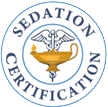(Content and time is flexible depending on Questions and needs of participants)
See our Event Calendar for dates to our next courses.
7:30-7:50
- Sign In Continental Breakfast
- Receive class handouts
7:50-8:00
- Administrative Remarks
8:00-10:00
- Scope of Practice
- History
- Definition levels of sedation
- State position statements on non-anesthetist RNs and sedation
- Indication for sedation
- Role of the sedation nurse
- The continuum of sedation
- General approaches to conducting safe and effective sedation
- Joint Commission policy and standards for patient sedation
10:00-10:15
- Break
10:15-12:15
- Pre-operative sedation assessment
- ASA physical status
- Airway assessment
- Airway adjuncts
- Monitoring
12:15-1:30
- Lunch on your own
1:30-3:30
- Medications
- Sedation/analgesic medications
- Anesthesia medications
- Reversal agents
- Emergency medications
- Complications
3:30-3:45
- Break
3:45-5:45
- Discharge
- Geriatric age specific considerations
- Pediatric sedation
- Adverse events
- The Nightingale Effect and nursing suggestions
5:45
- Evaluations and take home test for certification
Take home materials – Sedation Competency Manual, with PowerPoint Syllabus, Online Exam and Music.
THE LEARNER WILL BE ABLE TO:
· Discuss the differences between minimal sedation, moderate sedation, deep sedation, and general anesthesia.
· State 4 objectives/goals of sedation.
· Identify your institution’s policy regarding care of the patient undergoing sedation.
· Demonstrate care for the patient during pre-procedure, intra-procedure, and post-procedure phases of sedation.
· List the drugs, routes, and dosages for the drugs commonly used in moderate sedation.
· Discuss antidotes (dosage, side effects, indications) for commonly used drugs with sedation.
· Describe signs and symptoms of partial and complete airway obstruction.
· Demonstrate interventions to correct partial and complete airway obstruction.
· Identify side effects and contraindications to medications that have the potential to suppress a patient’s protective reflexes and respirations.
· Discuss the significance of utilizing the ASA classification during pre/post procedural pediatric and adult assessment.
· Integrate age-specific principles into care of the pediatric and geriatric patient undergoing moderate sedation.
· Document clearly, completely, and according to established standards, policies and instructions.
· Administer moderate sedation safely.
· Effectively manage complications which might arise during moderate sedation.
WHO SHOULD ATTEND
Nurses Working In:
– ER
– PACU
– Radiology
– Endoscopy
– Ophthalmology
– Operating Room
– Special Procedures
Participants will be able to take the certification exam on line. With a passing grade of 80% they will receive a certificate for CECs which can be printed after completion of exam and evaluation. Within two weeks the Participants will receive their Certification Certificate and a one year membership in the American Association of Moderate Sedation Nurses.
Event Calendar
For information call 865-269-4616 or email lena@sedationcertification.com
